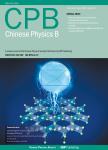Temperature-dependent photoluminescence of lead-free cesium tin halide perovskite microplates
作者机构:Shaanxi Joint Laboratory of GrapheneState Key Laboratory of Photon-Technology in Western China EnergyInternational Collaborative Center on Photoelectric Technology and Nano Functional MaterialsInstitute of Photonics&Photon-TechnologySchool of PhysicsNorthwest UniversityXi’an 710069China
出 版 物:《Chinese Physics B》 (中国物理B(英文版))
年 卷 期:2023年第32卷第11期
页 面:116-123页
核心收录:
学科分类:08[工学] 080501[工学-材料物理与化学] 0805[工学-材料科学与工程(可授工学、理学学位)] 0702[理学-物理学]
基 金:Project supported by the National Natural Science Foundation of China (Grant Nos. 11974279 12074311 12004310 and 12261141662)
主 题:cesium tin halide perovskite temperature-dependent photoluminescence chemical vapor deposi-tion microplate
摘 要:Tin halide perovskites recently have attracted extensive research attention due to their similar electronic and band structures but non-toxicity compared with their lead analogues. In this work, we prepare high-quality CsSnX_(3)(X=Br,I) microplates with lateral sizes of around 1–4 μm by chemical vapor deposition and investigate their low-temperature photoluminescence(PL) properties. A remarkable splitting of PL peaks of the CsSnBr_(3)microplate is observed at low temperatures. Besides the possible structural phase transition at below 70 K, the multi-peak fittings using Gauss functions and the power-dependent saturation phenomenon suggest that the PL could also be influenced by the conversion from the emission of bound excitons into free excitons. With the increase of temperature, the peak position shows a blueshift tendency for CsSnI_(3), which is governed by thermal expansion. However, the peak position of the CsSnBr3microplate exhibits a transition from redshift to blueshift at ~160 K. The full width at half maximum of CsSnX_(3)broadens with increasing temperature, and the fitting results imply that longitudinal optical phonons dominate the electron–phonon coupling and the coupling strength is much more robust in CsSnBr3than in CsSnI_(3). The PL intensity of CsSnX_(3)microplates is suppressed due to the enhanced non-radiative relaxation and exciton dissociation competing with radiative recombination. According to the Arrhenius law, the exciton binding energy of CsSnBr_(3)is ~38.4 meV, slightly smaller than that of CsSnI_(3).



